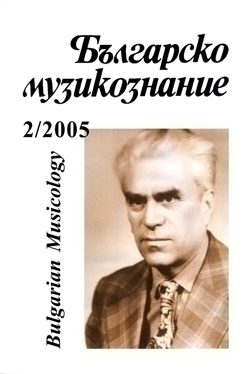Балкански извори за украинския „Болгарский напел” („Роспев”)? Към проблема за съотношението устност-писменост в източноправославната балканска...
Bulgarian Sources of the Ukrainian “Bolgarskij Napel” (“Rospev”)? Further on the Problem of the Correlation Between Oral and Written Tradition in...
Author(s): Elena TonchevaSubject(s): Music
Published by: Институт за изследване на изкуствата, Българска академия на науките
Summary/Abstract: Bulgarian Sources of the Ukrainian “Bolgarskij Napel” (“Rospev”)? Further on the Problem of the Correlation Between Oral and Written Tradition in Orthodox Singing on the Balkans The article continues the trend of studies, adopted by the author in the last few years – comparative studies of parallel in text chants, transcribed in both types of notation: the Balkan late Byzantine neumatic system and the Ukrainian Kiev staff notation. This is due to the discovery of another chant written by neumaic notation (from Zhegligovska anthology Athens № 928, late XV century), included in the Scythian Heirmologia, originating from the monastery “Great Skit “ in Galicia – a school of Bolgarskij napel (Bulgarian chant) in Ukraine (from the 16th century onward), which can be identified as Bulgarian in origin. This is the prosomoion in the first plagal mode “Prepodobni otche” (automelon). The problem here, however, is introduced in the correlation between oral and written chant tradition, and a comparison is made between music development in the West and the East in Europe. It is pointed out that whereas in the West after the 14th century the notation became “prescriptive” (Leo Treitler), in the East until the 19th century inclusive the neumatic script remained “descriptive”, based on oral performance (a constant transition between oral and written practice was preserved and the explicitness of the West European notation script was not achieved; but that has never been “an ideal” for the East European liturgical singing). After comparative studies of the two versions of the prosomoion “Prepodobni otche” (corelation between text-music, melody, respectively melodic lexis, rhythmics, modality), the following conclusions have been reached. Both transcriptions represent a transition from oral into a written type of chants. Basically, the two melodic versions, in which the psalmodic type of stylistics is preserved (melodic model, consisting of initium, tenor, and cadence is repeated several times, building up the composition) are similar. But they bear alterations, in accordance with the singing traditions, in which they participate. Particularly active are these alteration at the level of the melodic lexic – in the Ukrainian version the late Byzantine lexis is not accepted. On the basis of comparison of the two notational versions an attempt has been made to find rhythmic solutions to the late Byzantine melodic figures characteristic for the period (for in the field of rhythmics the neumatic script remains the most implicit). The conclusion is that the identification of the Ukrainian melody as Balkan in origin is possible. But the issue of the transition from oral to written practice remains open.
Journal: Българско музикознание
- Issue Year: 2005
- Issue No: 2
- Page Range: 3-28
- Page Count: 26
- Language: Bulgarian
- Content File-PDF

